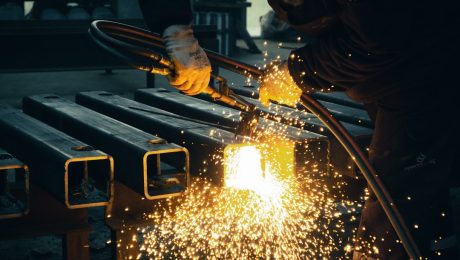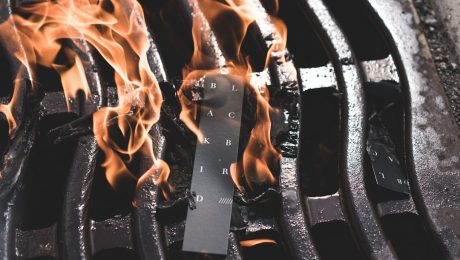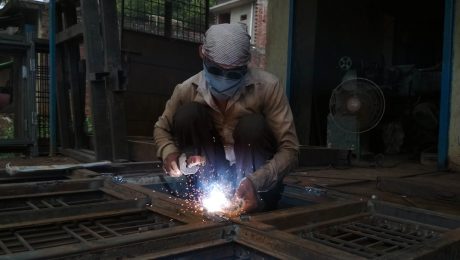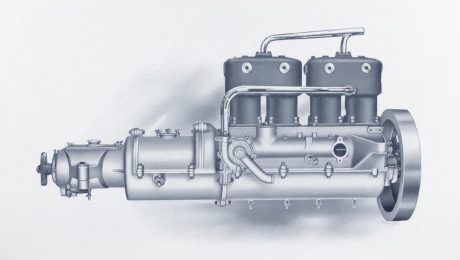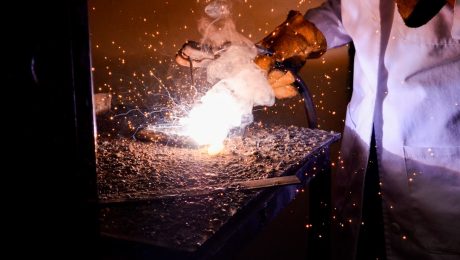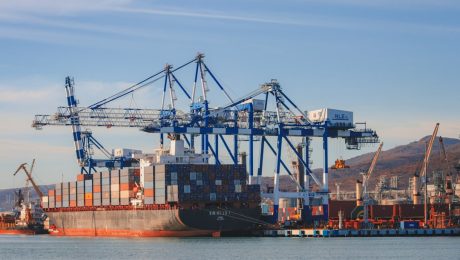body { font-family: sans-serif; line-height: 1.6; }
h1, h2, h3 { color: #333; }
h1 { font-size: 2.5em; }
h2 { font-size: 2em; }
h3 { font-size: 1.5em; }
code { background-color: #f0f0f0; padding: 2px 4px; border-radius: 4px; }
The international steel trade is a complex business, involving intricate logistical arrangements and a clear understanding of contractual obligations. Two crucial terms that define the responsibilities and costs associated with steel exports are FOB (Free On Board) and CIF (Cost, Insurance, and Freight). Understanding the nuances of FOB vs CIF is paramount for both buyers and sellers to avoid costly misunderstandings and disputes.
Understanding Incoterms: The Foundation of International Trade
Incoterms, or International Commercial Terms, are standardized trade terms published by the International Chamber of Commerce (ICC). These terms define the responsibilities of the buyer and seller in an international sale, specifically regarding delivery, costs, and risks. FOB and CIF are two of the most commonly used Incoterms in the steel industry, particularly for sea freight. Choosing the right Incoterm significantly impacts the cost, risk, and administrative burden on both parties.
FOB (Free On Board): Seller’s Responsibilities
Under FOB, the seller’s responsibilities end when the goods are loaded onto the vessel at the named port of shipment. This means the seller is responsible for:
- Manufacturing and preparing the steel goods for shipment.
- Delivering the goods to the named port of shipment.
- Loading the goods onto the vessel.
- Providing the necessary export documentation.
Importantly, the buyer is responsible for all costs and risks associated with the transportation from the port of shipment to the port of destination, including freight, insurance, and any potential damage or loss during transit. This means the buyer needs to arrange for shipping, insurance, and customs clearance at the destination port.
CIF (Cost, Insurance, and Freight): A More Comprehensive Approach
CIF is a more comprehensive Incoterm where the seller’s responsibilities extend beyond loading the goods onto the vessel. Under CIF, the seller is responsible for:
- All costs associated with delivering the goods to the named port of shipment, including manufacturing, packaging, and loading.
- The cost of freight to the named port of destination.
- The cost of marine insurance to cover the goods during transit.
- Providing the necessary export and shipping documentation.
The risk of loss or damage to the goods transfers to the buyer only once the goods are passed the ship’s rail at the port of shipment. However, the seller remains responsible for arranging the shipment and obtaining insurance coverage. The buyer’s responsibilities begin once the goods arrive at the port of destination, where they are responsible for customs clearance and inland transportation.
Cost and Risk Implications: FOB vs CIF
The choice between FOB and CIF significantly impacts both cost and risk. FOB generally results in lower costs for the seller as they are not responsible for freight and insurance. However, the buyer bears a greater risk and cost burden. Conversely, CIF offers the buyer greater security, as the seller handles the shipping and insurance arrangements. The higher cost for the seller under CIF reflects this added responsibility and risk mitigation.
For steel exports, the choice often depends on the buyer’s logistical capabilities and risk tolerance. Buyers with established logistics networks might prefer FOB to gain more control and potentially lower costs. Buyers with limited experience in international shipping might prefer the convenience and security of CIF, despite the higher cost.
Choosing the Right Incoterm: Factors to Consider
Selecting the appropriate Incoterm requires careful consideration of several factors:
- The buyer’s and seller’s experience in international trade: Experienced parties might prefer more flexible terms like FOB, while less experienced parties might find CIF more suitable.
- The relative bargaining power of the buyer and seller: The negotiation process can significantly influence the choice of Incoterm.
- The type and value of the steel products: High-value or specialized steel products might warrant the added security of CIF.
- The distance between the port of shipment and the port of destination: Longer distances might increase the buyer’s preference for CIF due to the complexity of international shipping.
- Insurance requirements: The buyer’s insurance needs and preferences will influence the choice of Incoterm.
It’s crucial to consult with legal and logistics professionals to ensure the chosen Incoterm accurately reflects the agreed-upon responsibilities and costs for both parties. A clearly defined contract that specifies the Incoterm and all related details is essential to avoid future disputes.
In conclusion, understanding the differences between FOB and CIF is crucial for successful steel exports. By carefully considering the implications of each Incoterm and negotiating a clear contract, both buyers and sellers can mitigate risks and ensure a smooth and profitable transaction.
SEO Tags:
- FOB Steel Export
- CIF Steel Export
- Incoterms Steel Trade
- International Steel Shipping
- Steel Export Contracts
Fire-resistant steel, a critical component in modern construction and industrial applications, offers unparalleled protection against the devastating effects of fire. Unlike materials that simply melt or weaken under intense heat, fire-resistant steel maintains its structural integrity for extended periods, allowing for safe evacuation and minimizing property damage. This comprehensive guide delves into the fascinating world of fire-resistant steel, exploring its properties, applications, and the science behind its remarkable heat resistance.
Understanding the Science Behind Fire-Resistant Steel
The secret to fire-resistant steel lies in its unique alloy composition. Standard carbon steel, while strong, loses its structural integrity at relatively low temperatures. Fire-resistant steel, however, incorporates specific alloying elements such as chromium, nickel, molybdenum, and silicon. These elements create a protective oxide layer on the steel’s surface, preventing further oxidation and maintaining its strength even at incredibly high temperatures. This oxide layer acts as a barrier, slowing down the rate at which heat penetrates the steel. The higher the concentration of these alloying elements, the greater the fire resistance. Furthermore, the microstructure of the steel plays a crucial role. A refined grain structure contributes to improved strength and toughness at high temperatures.
Different Grades and Their Applications
Fire-resistant steel isn’t a single material; it encompasses a range of grades, each with specific properties and applications. These grades are typically classified based on their fire resistance rating, determined through rigorous testing procedures. For example, some grades might be suitable for structural support in high-rise buildings, while others might be ideal for fire doors or industrial furnaces. The choice of grade depends on the specific requirements of the application, considering factors like the anticipated temperature exposure, duration of exposure, and the load-bearing capacity required. Commonly used grades often include those meeting standards like ASTM A240 and EN 10025, specifying chemical compositions and mechanical properties.
Testing and Standards for Fire-Resistant Steel
The fire resistance of steel is rigorously tested to ensure it meets stringent safety standards. Standard tests, such as those defined by ASTM and ISO, involve subjecting steel specimens to controlled fire conditions for specified durations. These tests measure the steel’s ability to maintain its load-bearing capacity, temperature rise, and overall structural integrity under intense heat. The results of these tests determine the fire resistance rating, which is crucial for obtaining building permits and ensuring compliance with fire safety regulations. These standards vary by region, so it’s vital to understand local building codes and relevant standards before selecting a specific grade of fire-resistant steel.
Advantages and Limitations of Fire-Resistant Steel
Fire-resistant steel offers numerous advantages, including its high strength-to-weight ratio, excellent ductility, and its ability to withstand high temperatures without significant loss of strength. Its use contributes to lighter building structures, reduced material costs in some applications, and enhanced fire safety. However, fire-resistant steel also has limitations. It can be more expensive than standard carbon steel, and its fabrication might require specialized techniques and equipment due to its higher strength and potential for work hardening. Furthermore, its corrosion resistance might be lower than that of some other high-temperature alloys, requiring appropriate surface treatments or coatings in certain environments.
Future Innovations in Fire-Resistant Steel Technology
Research and development in fire-resistant steel continue to push the boundaries of fire protection. Scientists are exploring new alloying elements and advanced manufacturing techniques to create even more resilient and cost-effective materials. Nanotechnology is showing promise in enhancing the protective oxide layer, further improving fire resistance. The development of lightweight, high-strength fire-resistant steels is also a significant area of focus, particularly for applications in aerospace and automotive industries. Furthermore, research is ongoing to develop self-healing coatings and materials that can automatically repair damage caused by high temperatures, enhancing the longevity and safety of fire-resistant steel structures.
In conclusion, fire-resistant steel is an indispensable material for ensuring safety and minimizing damage in high-risk environments. Its unique properties, stringent testing standards, and ongoing innovations make it a critical component in modern construction, industrial processes, and countless other applications where fire safety is paramount.
SEO Tags:
- Fire Resistant Steel
- Fireproof Steel
- High Temperature Steel
- Steel Alloys for Fire Protection
- Fire Safety Materials
Understanding the OEM Steel Component Landscape
Original Equipment Manufacturers (OEMs) rely heavily on high-quality steel components for a vast array of products, from automobiles and construction equipment to appliances and medical devices. The production of these components is a complex process, demanding precision, efficiency, and adherence to stringent quality standards. This intricate supply chain involves numerous steps, from initial material sourcing and design to manufacturing, quality control, and final delivery. The success of an OEM often hinges on the reliability and performance of these steel components, making this sector critically important to global manufacturing.
The demand for OEM steel components is driven by various factors, including technological advancements, increasing industrialization in developing economies, and the ongoing need for durable and reliable parts across diverse industries. Understanding the nuances of this landscape is crucial for both manufacturers and the OEMs they serve.
The Steel Selection Process: Material Matters
The choice of steel grade is paramount in OEM steel component production. The properties required vary significantly depending on the application. For instance, automotive parts might require high tensile strength and impact resistance, while components for medical devices necessitate biocompatibility and corrosion resistance. Common steel grades used include low-carbon steel, medium-carbon steel, high-carbon steel, alloy steels, and stainless steels. Each grade possesses a unique combination of properties, making the selection process a critical engineering decision.
Factors influencing steel selection include: the intended application’s stress levels, required durability, desired weight, cost considerations, and environmental conditions the component will endure. Advanced techniques like Finite Element Analysis (FEA) are frequently employed to simulate the performance of different steel grades under various operating conditions, ensuring optimal material selection for each specific component.
Manufacturing Processes: From Raw Material to Finished Product
The manufacturing process for OEM steel components is highly diverse, employing a range of techniques tailored to the specific design and required tolerances. Common methods include forging, casting, rolling, machining, and stamping. Forging involves shaping heated metal using pressure, resulting in high strength and durability. Casting involves pouring molten metal into a mold, suitable for complex shapes. Rolling produces flat sheets or bars of steel, often used as a precursor to other processes. Machining uses subtractive methods to remove material and achieve precise dimensions. Stamping involves pressing metal into a desired shape using a die.
The selection of the manufacturing process is determined by factors such as the component’s geometry, required tolerances, production volume, and cost-effectiveness. Often, a combination of processes is employed to achieve the desired outcome. For example, a forged component might undergo subsequent machining to refine its dimensions and surface finish.
Quality Control and Assurance: Ensuring Excellence
Maintaining stringent quality control throughout the OEM steel component production process is paramount. This involves rigorous testing and inspection at every stage, from raw material inspection to finished product verification. Common quality control measures include dimensional checks, hardness testing, tensile testing, impact testing, chemical analysis, and non-destructive testing (NDT) techniques such as ultrasonic testing and magnetic particle inspection. These methods ensure that components meet the specified requirements and are free from defects.
Implementing a robust quality management system, such as ISO 9001, is crucial for maintaining consistent quality and meeting customer expectations. This system involves documenting procedures, tracking processes, and continuously improving performance. Traceability is also essential, allowing for the identification and tracking of components throughout the entire production chain, enabling prompt identification and resolution of any quality issues.
The Future of OEM Steel Component Production: Innovation and Sustainability
The OEM steel component production industry is constantly evolving, driven by the need for improved efficiency, sustainability, and enhanced performance. Innovations such as additive manufacturing (3D printing) are gaining traction, offering the potential to produce complex shapes with minimal material waste. Advanced materials, such as high-strength low-alloy (HSLA) steels and advanced high-strength steels (AHSS), are being developed to enhance component performance and reduce weight. Furthermore, there’s a growing focus on sustainable practices, including reducing energy consumption, minimizing waste, and utilizing recycled steel.
The integration of Industry 4.0 technologies, such as automation, robotics, and data analytics, is transforming the production process, leading to increased efficiency, improved quality control, and reduced production costs. The future of OEM steel component production lies in embracing these advancements to deliver higher-quality components while minimizing environmental impact and maximizing efficiency.
Tags: OEM Steel Components, Steel Component Manufacturing, Steel Production, Quality Control in Manufacturing, Automotive Steel Parts
High-performance pipes are the backbone of numerous industries, from oil and gas to water management and chemical processing. Their ability to withstand extreme pressures, temperatures, and corrosive environments is crucial for efficient and safe operation. This post delves into the key features that differentiate high-performance pipes from standard piping systems, highlighting their impact on performance, longevity, and overall cost-effectiveness.
1. Superior Material Selection: The Foundation of Performance
The choice of material is paramount in determining a pipe’s performance capabilities. High-performance pipes often utilize advanced materials engineered to withstand specific challenges. For instance, super duplex stainless steels offer exceptional corrosion resistance and strength, making them ideal for harsh chemical environments. High-strength low-alloy (HSLA) steels provide excellent mechanical properties and weldability, suitable for demanding pressure applications. Other materials, such as titanium, nickel alloys, and fiberglass-reinforced polymers (FRP), are chosen based on specific requirements, such as high temperature resistance, lightweight construction, or chemical inertness. The selection process involves careful consideration of factors like operating temperature, pressure, the nature of the transported fluid, and the overall lifespan expectations of the piping system.
2. Enhanced Manufacturing Processes: Precision and Durability
Advanced manufacturing techniques play a crucial role in achieving high-performance pipe characteristics. Seamless pipes, produced through sophisticated extrusion or piercing processes, eliminate potential weld defects, enhancing strength and reducing the risk of failure. Advanced welding techniques, such as orbital welding, ensure high-quality, consistent welds with minimal imperfections. Furthermore, processes like cold forming and heat treatment optimize the material’s microstructure, improving its yield strength, ductility, and overall durability. These precision manufacturing methods contribute to the superior performance and reliability of high-performance pipes, minimizing the chances of leaks, cracks, or other failures during operation.
3. Advanced Coatings and Linings: Corrosion and Degradation Resistance
Protecting the pipe’s internal and external surfaces from corrosion and degradation is essential for maintaining its performance and extending its lifespan. High-performance pipes often incorporate advanced coatings and linings tailored to the specific operating conditions. Internal linings can be made of epoxy resins, polyurethane, or other polymers to prevent corrosion, reduce friction, and enhance flow characteristics. External coatings, such as fusion-bonded epoxy (FBE) or three-layer polyethylene (3LPE), protect against soil corrosion and environmental factors. The selection of appropriate coatings and linings is crucial for preventing material degradation, ensuring long-term performance, and minimizing maintenance requirements.
4. Optimized Design for Enhanced Flow and Efficiency
The design of high-performance pipes is optimized to enhance flow characteristics and minimize pressure drops. Features like smooth internal surfaces reduce friction losses, leading to improved energy efficiency and reduced pumping costs. The pipe diameter and configuration are carefully selected to optimize flow velocity and minimize turbulence, preventing erosion and maximizing throughput. In some applications, specialized fittings and bends are used to further enhance flow efficiency and reduce pressure losses. This focus on design optimization ensures that high-performance pipes operate at peak efficiency, contributing to significant cost savings over their lifespan.
5. Stringent Quality Control and Testing: Ensuring Reliability and Safety
Rigorous quality control and testing procedures are integral to ensuring the reliability and safety of high-performance pipes. Throughout the manufacturing process, stringent checks are performed to verify material properties, dimensional accuracy, and the integrity of welds and coatings. Non-destructive testing (NDT) methods, such as ultrasonic testing (UT), radiographic testing (RT), and magnetic particle testing (MT), are employed to detect any internal flaws or defects. Furthermore, hydrostatic testing or other pressure tests are conducted to verify the pipe’s ability to withstand the intended operating pressure. These comprehensive quality control and testing protocols guarantee the high performance and safety of high-performance pipes, minimizing the risk of failures and ensuring operational reliability.
In conclusion, high-performance pipes represent a significant advancement in piping technology. Their superior material selection, advanced manufacturing processes, protective coatings, optimized design, and stringent quality control contribute to enhanced efficiency, durability, and safety across various industries. Understanding these key features is crucial for selecting the right piping system for any given application, ensuring optimal performance and minimizing long-term costs.
SEO Tags:
- High-performance pipes
- Advanced piping systems
- Pipe material selection
- Pipe manufacturing techniques
- Corrosion resistant pipes
The steel manufacturing industry is a cornerstone of modern infrastructure, but its inherent processes present significant occupational safety challenges. From the intense heat of furnaces to the weight of massive steel ingots, the potential for accidents is ever-present. This comprehensive guide explores crucial aspects of occupational safety in steel manufacturing, aiming to highlight best practices and emphasize the importance of proactive risk management.
1. Identifying and Assessing Hazards in Steel Mills
Hazard identification is the foundational step in any effective safety program. Steel mills present a diverse range of hazards, broadly categorized as:
- Physical Hazards: These include extreme temperatures (both high and low), noise pollution (from machinery and processes), vibration, moving machinery (cranes, conveyors, rolling mills), sharp edges and objects, heavy lifting, and confined spaces.
- Chemical Hazards: Exposure to various chemicals, including molten metal fumes, dusts (e.g., silica dust), gases (e.g., carbon monoxide), and cleaning agents, poses significant health risks. Proper ventilation and respiratory protection are critical.
- Biological Hazards: While less prominent than physical and chemical hazards, biological hazards like bacteria and mold can exist in areas with standing water or poor sanitation.
- Ergonomic Hazards: Repetitive motions, awkward postures, and forceful exertions contribute to musculoskeletal disorders (MSDs) among workers. Ergonomic assessments and job redesign are essential to mitigate these risks.
- Heat-resistant clothing: Protective suits, gloves, and footwear designed to withstand high temperatures are essential for workers near furnaces and molten metal.
- Respiratory protection: Respirators, ranging from simple dust masks to self-contained breathing apparatus (SCBA), are vital for protecting against harmful dusts, fumes, and gases.
- Eye and face protection: Safety glasses, goggles, and face shields protect against flying debris, molten metal splashes, and intense light.
- Hearing protection: Earplugs or earmuffs are necessary to mitigate noise-induced hearing loss in high-noise environments.
- Safety footwear: Steel-toe boots protect feet from falling objects and crushing hazards.
- Hard hats: Essential for protection against falling objects.
- Engineering controls: These are the most effective controls, aiming to eliminate or reduce hazards at their source. Examples include machine guarding, improved ventilation systems, and ergonomic workstation design.
- Administrative controls: These involve changes to work procedures, training programs, and supervision to reduce exposure to hazards. Examples include job rotation, work-rest schedules, and safety meetings.
- Personal protective equipment (PPE): As discussed earlier, PPE is a crucial last line of defense when other controls are insufficient.
- Lockout/Tagout procedures: These procedures are essential for preventing accidental energization of machinery during maintenance or repair.
- Permit-to-work systems: These systems control access to high-risk areas and ensure that appropriate safety measures are in place before work commences.
- Emergency escape routes: Clearly marked and well-maintained escape routes are essential for quick and safe evacuation.
- Fire prevention and suppression: Regular fire drills, appropriate fire extinguishers, and sprinkler systems are crucial for fire safety.
- First aid and medical response: Designated first aid stations, trained first aiders, and readily available emergency medical services are vital.
- Emergency communication systems: Clear communication channels, including alarms, sirens, and two-way radios, are essential for coordinating emergency response.
- Emergency response teams: Trained emergency response teams can handle specific emergencies, such as chemical spills or fires.
- Hazard communication: Providing clear information about workplace hazards to employees.
- Machine guarding: Ensuring that machinery is properly guarded to prevent accidents.
- Confined space entry: Establishing procedures for safe entry and work in confined spaces.
- Personal protective equipment (PPE): Requiring the use of appropriate PPE and ensuring its proper maintenance.
- Emergency response planning: Developing and implementing effective emergency response plans.
- Record-keeping: Maintaining accurate records of accidents, injuries, and safety inspections.
A thorough hazard assessment, ideally using a systematic approach like Job Safety Analysis (JSA) or HAZOP (Hazard and Operability Study), is crucial to prioritize risks and develop targeted control measures.
2. Personal Protective Equipment (PPE) in Steel Manufacturing
Personal Protective Equipment (PPE) is a critical last line of defense against workplace hazards. The specific PPE required varies depending on the task and the identified hazards. Common PPE in steel mills includes:
Regular inspection and maintenance of PPE are vital to ensure its effectiveness. Proper training on the correct use and limitations of PPE is equally crucial.
3. Implementing Effective Risk Management Strategies
Risk management involves identifying, assessing, and controlling hazards to minimize the likelihood and severity of accidents. Key strategies include:
Regular reviews of risk assessments and safety procedures are necessary to adapt to changing conditions and technological advancements.
4. Emergency Procedures and Response in Steel Mills
Effective emergency response plans are critical for minimizing the consequences of accidents. Key elements include:
Regular training and drills are crucial to ensure that employees are familiar with emergency procedures and can respond effectively in case of an incident.
5. Compliance with Safety Regulations and Standards
Steel manufacturers must comply with a range of national and international safety regulations and standards. These regulations often cover aspects such as:
Staying updated on relevant regulations and standards is crucial for ensuring compliance and minimizing legal liabilities.
Implementing a robust occupational safety program in steel manufacturing requires a multifaceted approach, involving commitment from management, active participation from employees, and continuous improvement. By prioritizing safety, steel mills can create a safer and more productive work environment for all.
Tags: steel manufacturing safety, occupational safety, steel mill safety, industrial safety, workplace safety
body {
font-family: sans-serif;
line-height: 1.6;
}
h1, h2, h3 {
color: #333;
}
Cash. The physical manifestation of currency. For centuries, it’s been the cornerstone of global commerce, a tangible representation of value exchanged hand-to-hand. But in an increasingly digital world, is cash still king, or is it a relic of a bygone era? This comprehensive exploration dives into the multifaceted world of cash, examining its historical significance, modern-day advantages and disadvantages, its uncertain future, and the crucial security measures surrounding its use.
The Historical Significance of Cash: From Barter to Bitcoin
Before the advent of sophisticated financial systems, bartering was the primary method of exchange. This inefficient system, reliant on the “double coincidence of wants,” paved the way for the emergence of commodity money – goods with inherent value, like shells, salt, or livestock, used as a medium of exchange. Gradually, precious metals like gold and silver became preferred due to their durability, portability, and divisibility. The invention of coinage standardized these transactions, marking a significant leap forward. Paper money, initially representing a claim on precious metals held in reserve, followed, significantly simplifying transactions and facilitating larger-scale commerce. This evolution, from barter to today’s complex financial systems, underscores cash’s enduring role in human history. Its tangible nature provided a sense of security and control, a feeling that digital transactions sometimes lack.
Advantages of Cash: Privacy, Accessibility, and Simplicity
Even in our technologically advanced world, cash retains several key advantages. Firstly, it offers unparalleled privacy. Unlike digital transactions, which leave a digital trail, cash transactions are largely anonymous, protecting personal financial information from prying eyes. This is particularly crucial for individuals concerned about surveillance or those who prefer to keep their spending habits private. Secondly, cash remains incredibly accessible. Not everyone has a bank account or access to digital payment systems, making cash a vital tool for financial inclusion, especially in underserved communities. Finally, cash transactions are simple and straightforward. No need for internet access, apps, or complicated procedures – just a simple exchange of notes and coins.
Disadvantages of Cash: Security Risks, Inconvenience, and Illicit Activities
While cash offers distinct benefits, it also presents significant drawbacks. Security is a major concern. Carrying large sums of cash increases the risk of theft or loss. Furthermore, cash is susceptible to damage or deterioration, unlike digital records which are easily backed up. The inconvenience associated with cash is another significant disadvantage. Managing large amounts of cash can be cumbersome, and finding change or dealing with potential counterfeit bills adds further complications. Finally, the anonymity of cash makes it a preferred tool for illicit activities like money laundering, tax evasion, and the funding of criminal enterprises. This poses a significant challenge for law enforcement and regulatory bodies.
The Future of Cash: A Slow Decline or a Resilient Comeback?
The future of cash is a subject of ongoing debate. The rise of digital payments, contactless transactions, and cryptocurrencies is undoubtedly challenging the dominance of cash. Many governments are exploring the possibility of phasing out physical currency, driven by factors such as reduced costs associated with printing and distribution, and the increased ability to track financial flows for regulatory purposes. However, the persistence of cash’s advantages, particularly its accessibility and privacy, suggests that it won’t disappear entirely anytime soon. A likely scenario is a gradual decline in cash’s usage, with a coexistence of digital and physical forms of currency for the foreseeable future. The extent of cash’s decline will depend on factors like technological advancements, regulatory changes, and the evolving preferences of consumers.
Securing Your Cash: Protecting Yourself from Loss and Fraud
Safeguarding your cash is crucial. Avoid carrying large amounts of cash unnecessarily. Utilize secure methods of storage, such as safes or bank deposit boxes. Be vigilant when using cash in public places and avoid displaying large sums of money. Learn to identify counterfeit banknotes, paying close attention to security features. If you suspect you have received a counterfeit bill, report it to the authorities immediately. Regularly reconcile your cash balances to ensure accuracy and detect any discrepancies. By adopting these precautions, you can significantly reduce the risk of loss or fraud associated with handling cash.
In conclusion, cash’s journey from bartering to its current position in a digital age is a fascinating and complex one. While its future remains uncertain, its enduring presence highlights its inherent value and continued relevance in many aspects of our lives. The balance between the advantages and disadvantages will continue to shape its role in the global economy for years to come.
SEO Tags: cash, digital currency, future of cash, cash security, financial inclusion
In today’s fast-paced digital world, efficiency and customer satisfaction are paramount. Online quotation and ordering systems are no longer a luxury but a necessity for businesses aiming to stay competitive. These systems automate crucial processes, reducing manual workload and improving overall operational efficiency. This comprehensive guide will delve into the intricacies of these systems, highlighting their benefits and helping you determine if they’re the right fit for your business.
1. Boosting Efficiency with Automated Quotation Generation
Manually creating quotes can be time-consuming and prone to errors. Online quotation systems automate this process, significantly reducing the time it takes to provide quotes to potential clients. These systems often integrate with your inventory management system, allowing for real-time pricing and availability checks. Features like customizable templates, automatic calculations based on product specifications or service requirements, and the ability to generate quotes in various formats (PDF, email) further enhance efficiency. This automation frees up your team to focus on more strategic tasks, ultimately increasing productivity and profitability.
Furthermore, many systems allow for the inclusion of company branding and logos, ensuring a professional and consistent image across all quotes. This attention to detail strengthens your brand and improves the overall customer experience. The ability to track quote status and generate reports provides valuable insights into sales performance and areas for improvement.
2. Enhancing Customer Experience with Self-Service Ordering
Online ordering systems empower customers to take control of the ordering process. This self-service approach provides a seamless and convenient experience, leading to increased customer satisfaction. Customers can browse products or services, request quotes, place orders, and track their shipments—all without needing to interact with a sales representative. This 24/7 availability significantly improves response times and accommodates customers’ busy schedules.
The ability to customize orders, add special instructions, and access order history adds to the positive user experience. Clear and concise order confirmations and automated email updates keep customers informed throughout the process, reducing uncertainty and potential frustrations. This level of transparency fosters trust and strengthens customer relationships.
3. Streamlining Operations with Integrated Inventory Management
The integration of online quotation and ordering systems with inventory management is crucial for maintaining accurate stock levels and preventing overselling. Real-time inventory updates ensure that quotes and orders reflect current availability. This integration prevents potential delays and customer disappointment caused by unavailable items. Furthermore, it streamlines the fulfillment process, minimizing errors and ensuring efficient order processing.
Automated alerts for low stock levels allow businesses to proactively manage their inventory and avoid stockouts. This proactive approach minimizes disruptions to the supply chain and ensures continuous operation. Detailed inventory reports provide valuable insights into sales trends and help businesses optimize their stock levels for maximum efficiency.
4. Improving Accuracy and Reducing Errors with Automated Processes
Manual processes are inherently prone to human error. Online systems significantly reduce the risk of errors by automating many aspects of quotation and order management. Automated calculations, real-time data updates, and standardized processes ensure accuracy and consistency across all quotes and orders. This improves the overall quality of service and reduces the need for costly corrections or revisions.
The elimination of manual data entry minimizes the risk of transcription errors and ensures data integrity. Automated workflows streamline processes, ensuring that orders are processed efficiently and accurately. This precision contributes to a more professional image and builds customer trust.
5. Gaining Valuable Insights with Data Analytics and Reporting
Online quotation and ordering systems generate a wealth of valuable data that can be used to gain insights into business performance. Detailed reports on sales trends, customer behavior, and product popularity provide valuable information for strategic decision-making. This data-driven approach allows businesses to optimize their product offerings, pricing strategies, and marketing efforts.
Tracking key performance indicators (KPIs) like conversion rates, average order value, and customer acquisition cost helps businesses measure the effectiveness of their online quotation and ordering systems. This continuous monitoring allows for adjustments and improvements, ensuring the systems continue to deliver optimal results. The ability to customize reports based on specific needs further enhances the value of the data generated.
In conclusion, implementing online quotation and ordering systems is a strategic investment that offers significant benefits in terms of efficiency, customer satisfaction, and overall business growth. By automating key processes, reducing errors, and providing valuable insights, these systems empower businesses to operate more effectively and compete more successfully in today’s dynamic market.
SEO Tags:
Online Quotation System, Online Ordering System, Automated Quotation, Inventory Management System, E-commerce Solutions
Stainless steel. The name itself evokes images of durability, elegance, and hygiene. But with so many different types and grades available, choosing the right stainless steel product for your needs can feel overwhelming. This comprehensive guide will demystify the world of stainless steel, helping you navigate the options and make informed decisions.
Understanding Stainless Steel Grades: A Deep Dive into Composition
The properties of stainless steel are dictated by its composition, primarily the percentage of chromium. Chromium forms a passive layer of chromium oxide on the surface, protecting the steel from corrosion. Different grades of stainless steel contain varying amounts of chromium, nickel, molybdenum, and other alloying elements, resulting in distinct characteristics. Here are some key grades:
- 304 (18/8): This is the most common grade, offering excellent corrosion resistance and formability. It’s widely used in kitchenware, appliances, and architectural applications.
- 316 (18/10): Containing molybdenum, 316 stainless steel exhibits superior resistance to chloride corrosion, making it ideal for marine environments, chemical processing, and medical devices.
- 430: A ferritic stainless steel, 430 is less expensive than austenitic grades (like 304 and 316) but offers good corrosion resistance in less demanding applications. It’s often used in automotive parts and appliances.
- 410: A martensitic stainless steel known for its high strength and hardness after heat treatment. Commonly used in cutlery and tools.
Understanding these grades is crucial for selecting the right stainless steel for your specific application. Consider the environment, the required strength, and the level of corrosion resistance needed.
Common Applications of Stainless Steel: From Kitchen to Construction
The versatility of stainless steel is truly remarkable. Its wide range of properties allows it to be used in a vast array of applications across numerous industries. Let’s explore some key sectors:
- Food Service and Kitchenware: The hygiene and corrosion resistance of stainless steel make it a perfect choice for cookware, utensils, food processing equipment, and restaurant fixtures.
- Architecture and Construction: Stainless steel is used in building facades, roofing, structural elements, and handrails due to its durability, aesthetic appeal, and low maintenance requirements.
- Medical Devices: Biocompatibility and corrosion resistance are vital in medical applications. Stainless steel is used in surgical instruments, implants, and other medical devices.
- Automotive Industry: Stainless steel’s strength and corrosion resistance make it suitable for exhaust systems, body panels, and other automotive components.
- Chemical Processing: The resistance to many chemicals makes stainless steel a preferred material for tanks, pipes, and other equipment in chemical plants.
This is just a glimpse of the vast applications of stainless steel. Its adaptability continues to drive innovation across various sectors.
Choosing the Right Stainless Steel: Factors to Consider
Selecting the appropriate stainless steel involves careful consideration of several factors:
- Intended Use: The application dictates the required properties. A kitchen sink needs corrosion resistance, while a surgical instrument requires biocompatibility.
- Environmental Conditions: Exposure to chemicals, salt water, or extreme temperatures will influence the choice of grade.
- Budget: Different grades have varying costs. Choosing a less expensive grade might be appropriate for less demanding applications.
- Aesthetic Requirements: Surface finish, color, and reflectivity are important considerations for aesthetic applications.
- Formability and Weldability: These factors are crucial for manufacturing processes.
Thorough consideration of these factors will ensure you select the optimal stainless steel for your specific needs.
Caring for Your Stainless Steel Products: Maintenance and Cleaning
Proper care will extend the lifespan and maintain the beauty of your stainless steel products. Here are some essential tips:
- Regular Cleaning: Use mild soap and water for regular cleaning. Avoid abrasive cleaners that can scratch the surface.
- Stain Removal: Address stains promptly. Many stains can be removed with a paste of baking soda and water.
- Preventing Water Spots: Dry your stainless steel surfaces after cleaning to prevent water spots.
- Protecting from Scratches: Use soft cloths and avoid abrasive materials when cleaning or handling.
- Specific Cleaning Products: For stubborn stains or heavily soiled areas, consider using specialized stainless steel cleaners.
Following these simple guidelines will help keep your stainless steel products looking their best for years to come.
The Future of Stainless Steel: Innovations and Trends
The development of new stainless steel grades and manufacturing processes continues to push the boundaries of this versatile material. Current trends include:
- High-Strength Stainless Steels: These grades offer increased strength and reduced weight, making them ideal for structural applications.
- Advanced Surface Treatments: New surface treatments enhance corrosion resistance, aesthetics, and hygiene.
- Sustainability Initiatives: The industry is focusing on sustainable manufacturing practices and the use of recycled stainless steel.
- Additive Manufacturing: 3D printing is opening up new possibilities for complex shapes and customized designs.
The future of stainless steel is bright, with ongoing innovation promising even greater performance and wider applications.
This comprehensive guide provides a solid foundation for understanding and selecting the right stainless steel products. Remember to carefully consider the factors discussed to ensure you make the best choice for your specific application.
Tags: stainless steel, stainless steel guide, stainless steel types, stainless steel grades, stainless steel applications
body {
font-family: sans-serif;
line-height: 1.6;
}
h1, h2, h3 {
color: #333;
}
img {
max-width: 100%;
height: auto;
}
Construction nails are seemingly simple components, yet their selection significantly impacts the longevity and structural integrity of any building project. Choosing the right nail requires understanding various standards, material properties, and how these factors contribute to overall durability. This comprehensive guide explores the crucial aspects of construction nails, ensuring you make informed decisions for your next project.
Understanding Construction Nail Standards: Size, Gauge, and Type
Construction nails are categorized by several key characteristics. The most important are size (length), gauge (thickness), and type (e.g., common, box, finishing). Size is measured in inches or centimeters and directly relates to the material’s thickness being fastened. Gauge refers to the nail’s diameter, with lower gauges representing thicker nails. Different types of nails are designed for specific applications. Common nails are general-purpose, box nails have a larger head for holding power, and finishing nails have a smaller head for a less visible finish. Standards like those set by ASTM International provide specifications for dimensions, material properties, and performance requirements, ensuring consistency and quality across manufacturers.
For example, an 8d common nail (8 penny) is approximately 2.5 inches long and has a specific gauge. Understanding these standards is crucial for selecting the appropriate nail for a given application. Using a nail that’s too short can lead to insufficient holding power, while using one that’s too long can cause damage to the materials or even penetrate through to the other side.
Material Matters: The Impact of Steel and Other Alloys on Nail Durability
The material composition of a construction nail significantly impacts its durability and resistance to corrosion. The most common material is steel, which can be further treated to enhance its properties. Galvanized nails, coated with zinc, offer superior corrosion resistance, making them ideal for outdoor applications and environments with high humidity. Stainless steel nails provide even greater corrosion resistance, but they are typically more expensive. Other alloys, such as those containing copper, might be used for specific applications requiring enhanced resistance to certain chemicals or environmental factors.
The choice of material should be guided by the intended application and the environmental conditions. For interior projects in dry environments, standard steel nails might suffice. However, for exterior work or projects exposed to moisture, galvanized or stainless steel nails are strongly recommended to prevent rust and ensure long-term durability.
Nail Holding Power and Penetration: Factors Affecting Structural Integrity
The holding power of a nail depends on several factors, including its length, gauge, material, and the type of wood or material being fastened. A longer and thicker nail will generally provide greater holding power. The sharpness of the nail point also plays a crucial role; a sharp point allows for easier penetration and a more secure hold. The type of wood also matters; denser woods require longer and thicker nails than softer woods.
Proper nail placement is also critical. Nails should be driven straight to avoid splitting the wood. Pre-drilling pilot holes can be helpful for preventing splitting, especially when working with hardwoods or using longer nails. Understanding these factors is essential for ensuring the structural integrity of any construction project.
Common Nail Types and Their Applications: Choosing the Right Tool for the Job
Various nail types cater to different applications. We’ve already mentioned common, box, and finishing nails. Beyond these, there are specialized nails like roofing nails (with a large head for wind resistance), brads (small, thin nails for finishing work), and casing nails (for trim work). Each nail type has specific design features optimized for its intended use. Using the wrong type of nail can compromise the project’s aesthetics or structural integrity.
For instance, using finishing nails where structural strength is needed would be inappropriate. Similarly, using common nails for fine carpentry work would leave an undesirable finish. Selecting the correct nail type ensures both functionality and a professional-looking result.
Ensuring Durability: Best Practices for Nail Installation and Project Longevity
Even with the right nail selection, proper installation is crucial for long-term durability. Using a nail gun can improve efficiency and ensure consistent penetration depth. However, hand nailing allows for more control and precision, especially in delicate situations. Regardless of the method, avoiding bending or damaging the nail during installation is important. Properly setting the nail head flush with the surface prevents snags and improves the overall aesthetic appeal.
Regular inspections, especially in projects exposed to harsh weather conditions, can help identify any problems early on. Replacing loose or damaged nails promptly prevents further deterioration and ensures the longevity of the structure. Proper maintenance and timely repairs contribute significantly to the overall durability of any project utilizing nails.
By understanding the standards, material properties, and best practices discussed in this guide, you can ensure that your construction projects benefit from the strength and durability that properly selected and installed nails provide.
SEO-Friendly Tags:
- construction nails
- nail gauge
- nail size
- galvanized nails
- nail durability
In today’s globally interconnected economy, the efficient movement of goods is paramount. This requires a sophisticated understanding and implementation of both maritime and land logistics strategies. A seamless integration of these two crucial components is key to minimizing costs, reducing transit times, and ensuring the timely delivery of products to consumers worldwide. This post will delve into the key elements of a successful integrated logistics approach.
1. Optimizing the Maritime Leg: Charting a Course for Efficiency
The maritime leg often forms the backbone of global supply chains. Optimizing this stage involves several crucial steps: selecting the appropriate vessel type (container ships, bulk carriers, tankers etc.) based on cargo characteristics and volume; choosing optimal shipping routes considering factors such as weather patterns, canal availability (Suez, Panama), and potential geopolitical risks; and meticulously planning cargo handling procedures at ports to minimize delays and congestion. Efficient port operations, including streamlined customs processes and effective yard management, are critical. Utilizing advanced technologies such as AI-powered route optimization software and predictive analytics can significantly improve efficiency and reduce costs. Furthermore, leveraging container tracking systems provides real-time visibility into cargo location and status, enabling proactive risk mitigation.
2. Land-Based Logistics: The Final Mile and Beyond
Once cargo reaches its destination port, the land-based logistics network takes over. This phase encompasses a range of activities, including customs clearance, inland transportation (trucking, rail, intermodal), warehousing, and final-mile delivery. Effective land logistics requires careful consideration of several factors. Choosing the right transportation mode depends on factors such as distance, cost, delivery speed, and cargo type. For example, rail transport is often cost-effective for long distances, while trucking offers greater flexibility for shorter distances and last-mile delivery. Efficient warehouse management, including inventory control and order fulfillment processes, is crucial for minimizing storage costs and ensuring timely order processing. The final mile delivery, often the most expensive and challenging part of the process, requires optimized routing, efficient delivery scheduling, and potentially the use of specialized vehicles for different types of goods.
3. Integrating Maritime and Land Logistics: A Holistic Approach
The true power lies in seamlessly integrating maritime and land logistics. This requires a holistic approach that considers the entire supply chain as a single, interconnected system. Effective communication and collaboration between different stakeholders – shippers, carriers, freight forwarders, customs brokers, and warehouse operators – are essential. Utilizing a Transportation Management System (TMS) can significantly enhance coordination and visibility across the entire supply chain. A TMS provides a centralized platform for managing shipments, tracking cargo, optimizing routes, and automating various processes. Real-time data sharing and collaborative platforms enable faster decision-making and improved responsiveness to unexpected events. This integrated approach allows for proactive identification and mitigation of potential disruptions, ultimately leading to greater efficiency and cost savings.
4. Risk Management in Maritime and Land Logistics: Mitigating Potential Disruptions
Global supply chains are inherently vulnerable to various risks, including geopolitical instability, natural disasters, port congestion, and theft. A robust risk management strategy is crucial for mitigating these potential disruptions. This involves identifying potential risks, assessing their likelihood and impact, and developing contingency plans to minimize their effects. Insurance coverage is essential to protect against financial losses resulting from unforeseen events. Diversifying transportation routes and suppliers can also help reduce reliance on single points of failure. Implementing robust security measures, such as GPS tracking and cargo monitoring systems, can help prevent theft and loss. Regularly reviewing and updating the risk management plan is crucial to adapt to changing circumstances and emerging threats.
5. Technology’s Role in Enhancing Maritime and Land Logistics: Embracing Innovation
Technological advancements are revolutionizing the logistics industry. The adoption of innovative technologies such as blockchain, IoT (Internet of Things), and AI is transforming how goods are moved and managed. Blockchain technology can enhance transparency and security by providing immutable records of transactions and cargo movements. IoT sensors can track cargo in real-time, providing valuable data on location, temperature, and humidity. AI-powered analytics can optimize routes, predict delays, and improve forecasting accuracy. The integration of these technologies can significantly improve efficiency, reduce costs, and enhance the overall resilience of supply chains. Companies that embrace innovation and adopt cutting-edge technologies will be better positioned to compete in the increasingly dynamic global marketplace.
By strategically integrating maritime and land logistics, embracing technological advancements, and implementing robust risk management strategies, businesses can optimize their supply chains, reduce costs, and deliver exceptional value to their customers. The key to success lies in a holistic approach that prioritizes efficiency, collaboration, and continuous improvement.
SEO Tags:
Maritime Logistics, Land Logistics, Supply Chain Management, Logistics Optimization, Global Supply Chain

